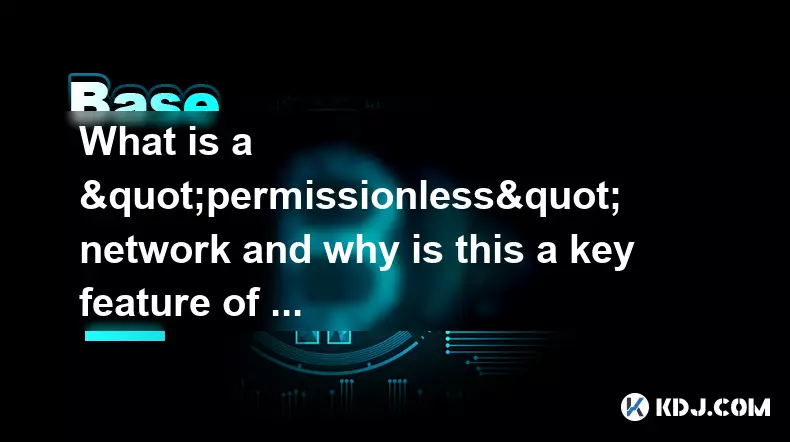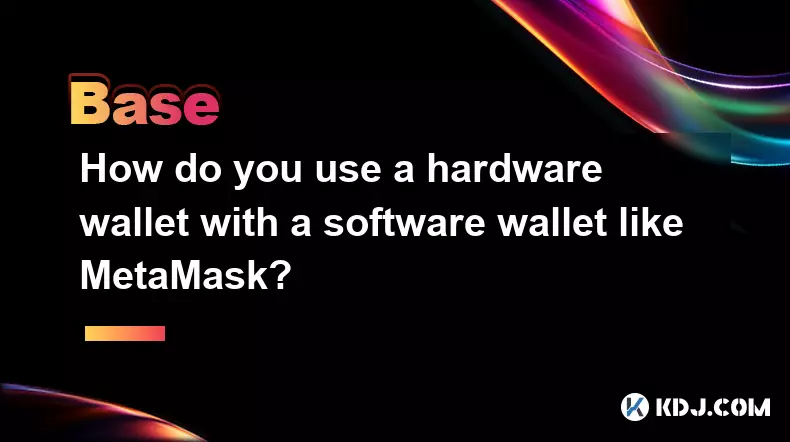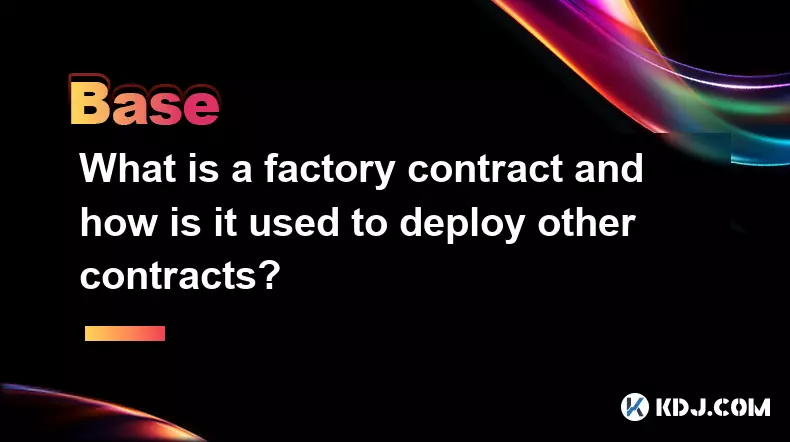-
 bitcoin
bitcoin $101752.865364 USD
-1.09% -
 ethereum
ethereum $3382.985899 USD
-1.38% -
 tether
tether $0.999658 USD
0.04% -
 xrp
xrp $2.272505 USD
-1.51% -
 bnb
bnb $989.089004 USD
0.14% -
 solana
solana $156.962612 USD
-3.08% -
 usd-coin
usd-coin $0.999776 USD
0.01% -
 tron
tron $0.290786 USD
-0.69% -
 dogecoin
dogecoin $0.174594 USD
-2.86% -
 cardano
cardano $0.560085 USD
-3.55% -
 hyperliquid
hyperliquid $40.023704 USD
-5.75% -
 chainlink
chainlink $15.324649 USD
-2.78% -
 bitcoin-cash
bitcoin-cash $493.576540 USD
-3.52% -
 zcash
zcash $571.320038 USD
-12.05% -
 stellar
stellar $0.280066 USD
-4.26%
What is a "permissionless" network and why is this a key feature of crypto?
A permissionless network allows open, trustless participation in cryptocurrency systems, where decentralization, transparency, and incentives ensure security and innovation.
Nov 09, 2025 at 08:40 am

What Defines a Permissionless Network in Cryptocurrency?
1. A permissionless network operates without centralized control, allowing anyone to participate without needing approval from a governing body. This means individuals can join the network, validate transactions, or mine blocks freely. The absence of gatekeepers ensures that no single entity holds dominance over operations.
2. In such systems, consensus mechanisms like Proof of Work or Proof of Stake enable participants to agree on the state of the blockchain. These protocols secure the network while maintaining decentralization. Nodes contribute computing power or stake assets to verify data integrity.
3. Open access fosters innovation by enabling developers to build decentralized applications (dApps) without seeking authorization. Smart contracts deploy seamlessly across the network, executing automatically when conditions are met. This environment encourages experimentation and rapid iteration.
4. Transparency is inherent in permissionless networks, as every transaction is recorded on a public ledger. Anyone can audit the blockchain, ensuring accountability and reducing opportunities for manipulation. This level of visibility strengthens trust among users who rely on cryptographic verification rather than institutional oversight.
Why Decentralized Access Matters in Crypto
1. Financial inclusion expands significantly under permissionless models. Individuals without access to traditional banking infrastructure can transact globally using only an internet connection. Wallets are created instantly, bypassing bureaucratic hurdles associated with conventional finance.
2. Censorship resistance emerges as a direct consequence of open participation. Transactions cannot be blocked or reversed by authorities due to the distributed nature of validation. This feature proves critical in regions where governments restrict capital movement or monitor financial activity.
3. Security improves because attackers must compromise a majority of nodes simultaneously to alter records—a feat that grows increasingly difficult as the network expands. The economic cost of such an attack often outweighs potential gains, deterring malicious actors.
4. Trust shifts from institutions to code. Users rely on cryptographic proofs and algorithmic rules instead of intermediaries. This transition reduces counterparty risk and minimizes reliance on third parties for transaction validation.
The Role of Incentives in Sustaining Permissionless Systems
1. Miners and validators receive rewards in the form of native tokens for securing the network. These incentives align individual interests with network health, encouraging honest behavior. Dishonest actions result in financial penalties or loss of staked assets.
2. Tokenomics play a crucial role in maintaining long-term viability. Well-designed emission schedules and reward structures prevent inflationary pressures while ensuring sufficient motivation for continued participation.
3. Community governance allows stakeholders to propose and vote on protocol upgrades. Changes are implemented based on collective agreement rather than unilateral decisions. This democratic process reinforces the ethos of decentralization.
4. The continuous influx of new participants strengthens network effects, making the system more resilient and valuable over time. As adoption increases, the cost of attacking the network rises proportionally, further solidifying its security model.
Common Challenges Faced by Permissionless Networks
1. Scalability remains a persistent issue, as increased transaction volume can lead to congestion and higher fees. Solutions like layer-2 protocols and sharding aim to address these limitations without compromising decentralization.
2. Regulatory scrutiny intensifies as permissionless networks gain prominence. Governments may view them as threats to monetary sovereignty or tools for illicit activities, prompting calls for restrictions or oversight.
3. User experience often lags behind centralized platforms. Managing private keys, understanding gas fees, and navigating wallet interfaces present barriers to mainstream adoption.
4. Despite these challenges, the core principle of unrestricted access continues to drive innovation and attract users disillusioned with traditional financial systems.
Frequently Asked Questions
How does a permissionless network differ from a permissioned one?A permissionless network allows anyone to join and participate without approval, whereas a permissioned network restricts access to verified entities. In permissioned systems, organizations control node operation and transaction validation, limiting openness but potentially increasing efficiency.
Can permissionless blockchains be regulated?Regulation targets user behavior and service providers rather than the protocol itself. Exchanges, wallets, and custodians become compliance points, but the underlying network remains autonomous. Enforcement focuses on on-ramps and off-ramps to traditional finance.
Are all cryptocurrencies built on permissionless networks?No. While Bitcoin and Ethereum operate on permissionless models, some enterprise-focused blockchains are permissioned. These are typically used within consortiums where trust exists among members, and control is shared among predefined participants.
What prevents bad actors from exploiting permissionless systems?Cryptoeconomic design discourages malicious activity through financial disincentives. Attackers risk losing staked funds or mining rewards if they act dishonestly. Additionally, the transparency of the ledger makes fraudulent transactions easily detectable by the community.
Disclaimer:info@kdj.com
The information provided is not trading advice. kdj.com does not assume any responsibility for any investments made based on the information provided in this article. Cryptocurrencies are highly volatile and it is highly recommended that you invest with caution after thorough research!
If you believe that the content used on this website infringes your copyright, please contact us immediately (info@kdj.com) and we will delete it promptly.
- Ripple (XRP) in 2026: Hold or Fold? A Look at XRP's Future and Emerging DeFi Alternatives
- 2025-11-08 18:35:01
- Zcash ZEC Coin Price Explosion: From Privacy Niche to Center Stage
- 2025-11-08 18:55:01
- Berachain Price Prediction: Navigating the Honeycomb Hype in Crypto
- 2025-11-08 18:55:01
- Arthur Hayes, Gold, and Bitcoin: A Modern Monetary Trinity?
- 2025-11-08 19:15:01
- Shiba Inu's Next Move: Navigating a Shifting Market
- 2025-11-08 19:20:01
- Pakistan's Crypto Crossroads: Balancing Opportunity with Asset-Backed Realities
- 2025-11-08 19:20:01
Related knowledge

How does a crypto insurance protocol work?
Nov 08,2025 at 12:39am
Understanding Crypto Insurance Protocols1. A crypto insurance protocol operates by offering financial protection against losses incurred from digital ...

What is token composability and why is it called "DeFi Legos"?
Nov 09,2025 at 06:39am
Bitcoin's Role in Decentralized Finance1. Bitcoin remains the cornerstone of decentralized finance, serving as a benchmark for value and trustlessness...

What is an "exploit" versus a "hack" in the context of smart contracts?
Nov 09,2025 at 12:40am
Understanding Exploits in Smart Contracts1. An exploit refers to the utilization of a known vulnerability within a smart contract’s code to gain unint...

What is a decentralized storage network and how does it compare to cloud services?
Nov 07,2025 at 11:59pm
Understanding Decentralized Storage Networks1. A decentralized storage network distributes data across a peer-to-peer infrastructure rather than relyi...

How do you use a hardware wallet with a software wallet like MetaMask?
Nov 09,2025 at 04:20am
Connecting a Hardware Wallet to MetaMask1. Ensure your hardware wallet is updated with the latest firmware. Devices like Ledger or Trezor require up-t...

What is a factory contract and how is it used to deploy other contracts?
Nov 08,2025 at 04:20am
Understanding Factory Contracts in Blockchain Development1. A factory contract is a smart contract designed to create and deploy other smart contracts...

How does a crypto insurance protocol work?
Nov 08,2025 at 12:39am
Understanding Crypto Insurance Protocols1. A crypto insurance protocol operates by offering financial protection against losses incurred from digital ...

What is token composability and why is it called "DeFi Legos"?
Nov 09,2025 at 06:39am
Bitcoin's Role in Decentralized Finance1. Bitcoin remains the cornerstone of decentralized finance, serving as a benchmark for value and trustlessness...

What is an "exploit" versus a "hack" in the context of smart contracts?
Nov 09,2025 at 12:40am
Understanding Exploits in Smart Contracts1. An exploit refers to the utilization of a known vulnerability within a smart contract’s code to gain unint...

What is a decentralized storage network and how does it compare to cloud services?
Nov 07,2025 at 11:59pm
Understanding Decentralized Storage Networks1. A decentralized storage network distributes data across a peer-to-peer infrastructure rather than relyi...

How do you use a hardware wallet with a software wallet like MetaMask?
Nov 09,2025 at 04:20am
Connecting a Hardware Wallet to MetaMask1. Ensure your hardware wallet is updated with the latest firmware. Devices like Ledger or Trezor require up-t...

What is a factory contract and how is it used to deploy other contracts?
Nov 08,2025 at 04:20am
Understanding Factory Contracts in Blockchain Development1. A factory contract is a smart contract designed to create and deploy other smart contracts...
See all articles





















![The Graph Price Prediction [GRT Crypto Price News Today] The Graph Price Prediction [GRT Crypto Price News Today]](/uploads/2025/11/07/cryptocurrencies-news/videos/690d4df44fe69_image_500_375.webp)



















































